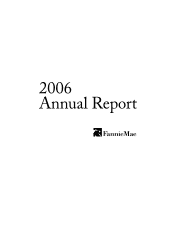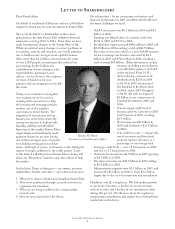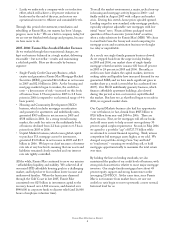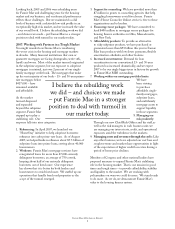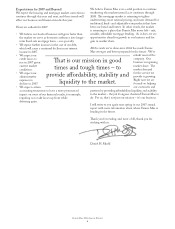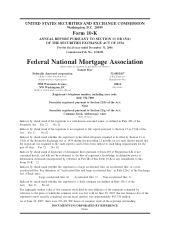Fannie Mae 2006 Annual Report Download - page 7
Download and view the complete annual report
Please find page 7 of the 2006 Fannie Mae annual report below. You can navigate through the pages in the report by either clicking on the pages listed below, or by using the keyword search tool below to find specific information within the annual report.
Looking back, 2005 and 2006 were rebuilding years
for Fannie Mae and challenging years for the housing
market and our business, and our financial performance
reflects those challenges. But we maintained a solid
book of business with a relatively low-risk profile in an
exceptionally high-risk market, and we increased the value
of our overall book. I believe the rebuilding work we did
– and choices we made – put Fannie Mae in a stronger
position to deal with turmoil in our market today.
2007: Working with Partners in a Tough Market
You might wonder how Fannie Mae is weathering
the worst crisis in the housing and mortgage markets
in decades. Many financial institutions that own or
guarantee mortgages are facing downgrades, write-offs,
layoffs and worse. Most of the market turmoil originated
in the subprime segment, but our exposure to subprime
mortgages is minimal, just over 2 percent of our single-
family mortgage credit book. e mortgages that make
up the vast majority of our book – 15- and 30-year prime-
rate mortgages below
$417,000 – have
remained available
and affordable.
As the market
turmoil deepened
and expanded
beyond the subprime
segment, Fannie Mae
stepped up to play a
stabilizing role. Our
response falls into nine categories:
1. Refinancing: In April 2007, we launched our
“HomeStay” initiative to help subprime borrowers
refinance into safer prime-rate loans. As of August
2007, we helped lenders refinance about $7.5 billion of
subprime loans into prime loans, serving about 40,000
homeowners.
2. Workouts: Fannie Mae’s mortgage servicers have
renegotiated loans for more than 27,000 seriously
delinquent borrowers, an average of 750 a week,
keeping about half of our seriously delinquent
borrowers out of foreclosure. Our experience
has shown that it is better for both lenders and
homeowners to avoid foreclosure. We staffed up our
operations that handle foreclosed properties as the
scope of the turmoil emerged.
3. Support for counseling: We have provided more than
$7 million in grants to counseling agencies that help
struggling homeowners avoid foreclosure. Fannie
Mae’s Home Counselor Online service is free to these
organizations and to lenders.
4. Financing rescue packages: We have committed to
fund $450 million in mortgage rescue packages for
housing finance authorities in Ohio, Massachusetts,
and New York.
5. Affordability products: To provide an alternative
to risky subprime products, we have purchased or
guaranteed more than $53 billion this year in Fannie
Mae loan products with low down payments, flexible
amortization schedules, and other features.
6. Increased securitization: Demand for loan
securitization in our conventional 15- and 30-year
products has increased dramatically, and we expect
2007 to be our single biggest year in history for growth
in Fannie Mae MBS outstanding.
7. Working within our mortgage portfolio limits:
We have
been striving
to purchase
affordable single-
family mortgages,
subprime loans,
and multifamily
mortgage assets to
support liquidity
in those segments.
8. Managing our
risk prudently:
rough our new Chief Risk Officer and his staff, as
well as the risk managers in each business unit, we
are managing our interest rate, credit, and operational
exposures amid the turbulence in the markets.
9. Managing costs and revenues through the cycle: Like
any other business, we have adjusted our cost base and
sought revenue and market share opportunities in light
of the expectation of higher credit loss ratios during a
period of home price declines.
Members of Congress and other national leaders have
proposed measures to expand Fannie Mae’s stabilizing
role in the housing market. at is our mission in good
times and tough times – to provide affordability, stability
and liquidity to the market. We are working with
policymakers on ways we could do more. We stand ready
to do more. As we do, we demonstrate Fannie Mae’s
value to the housing finance system.
I believe the rebuilding work
we did – and choices we made
– put Fannie Mae in a stronger
position to deal with turmoil in
our market today.
F M 2006 A R
5

